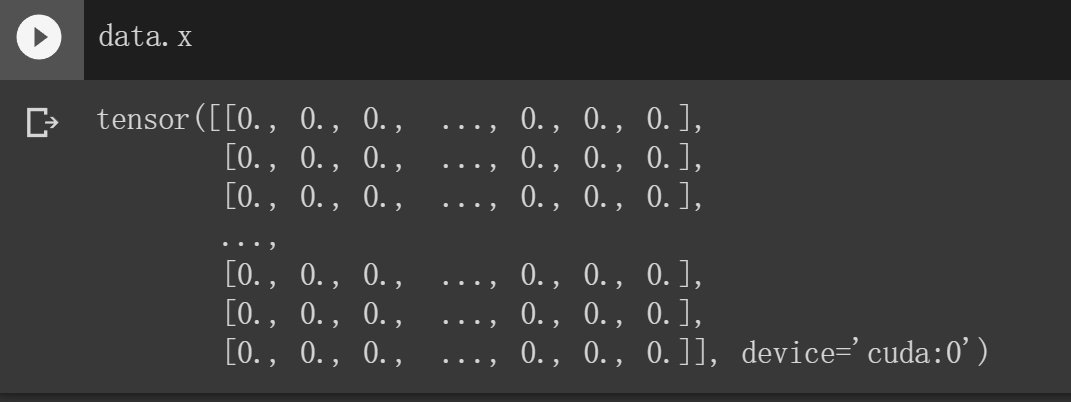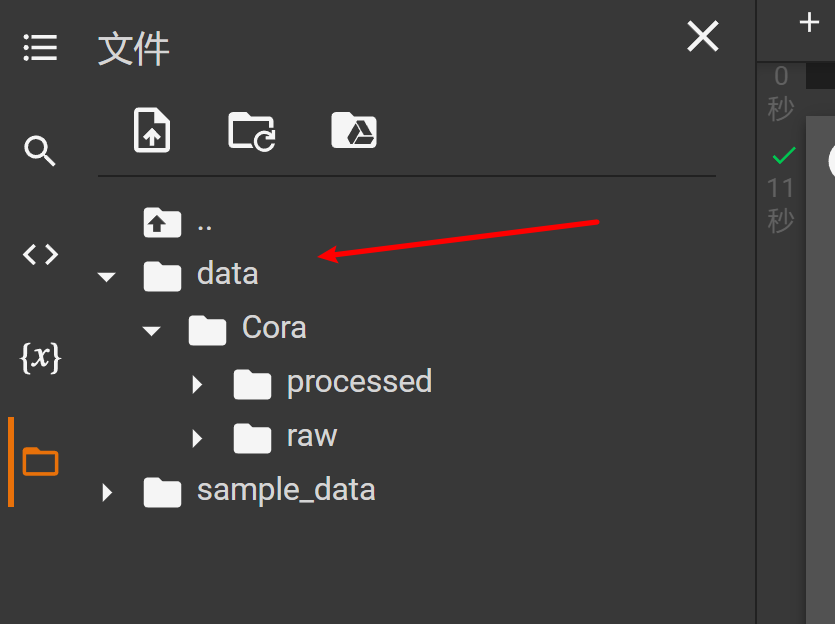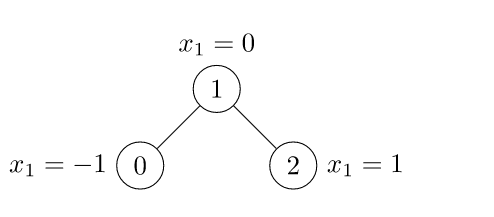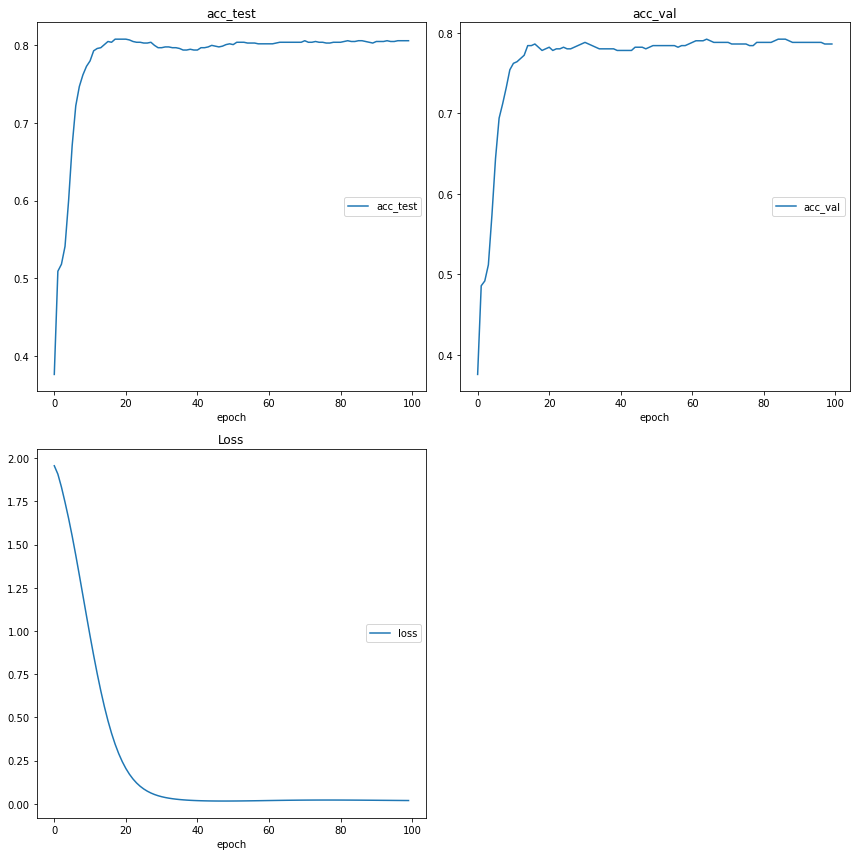https://mydoc.myencyclopedia.top/pub-html/03_gcn.html
https://www.bilibili.com/video/BV1f3411i7MQ?p=3
https://blog.csdn.net/StarfishCu/article/details/109132437GCN学习:用PyG实现自定义layers的GCN网络及训练(五)
使用
import numpy as npimport torchimport torch.nn as nnimport torch.nn.functional as F
from torch_geometric.datasets import Planetoidimport torch_geometric.transforms as Tname_data = 'Cora'dataset = Planetoid(root='data', name=name_data)# dataset.transform = T.NormalizeFeatures()print(f"Number of Classes in {name_data}:", dataset.num_classes)print(f"Number of Node Features in {name_data}:", dataset.num_node_features)device = torch.device('cuda' if torch.cuda.is_available() else 'cpu')data = dataset[0].to(device)>>>Number of Classes in Cora: 7Number of Node Features in Cora: 1433dataset.data#Data(x=[2708, 1433], edge_index=[2, 10556], y=[2708], train_mask=[2708], val_mask=[2708], test_mask=[2708])
因为len(dataset) =1,也就是说数据集里只有一张图,所以只需 data = dataset[0].to(device) 可以看到数据已经转移到了cuda中了
可以看到数据已经转移到了cuda中了
封装函数
train
def train(model, data, optimizer):model.train()optimizer.zero_grad()out = model(data)loss = F.nll_loss(out[data.train_mask], data.y[data.train_mask])loss.backward()optimizer.step()return loss.item()
Test
@torch.no_grad()def test(model, data):model.eval()_, pred = model(data).max(dim=1)correct_train = pred[data.train_mask].eq(data.y[data.train_mask]).sum().item()acc_train = correct_train / data.train_mask.sum().item()correct_val = pred[data.val_mask].eq(data.y[data.val_mask]).sum().item()acc_val = correct_val / data.val_mask.sum().item()correct_test = pred[data.test_mask].eq(data.y[data.test_mask]).sum().item()acc_test = correct_test / data.test_mask.sum().item()return acc_train, acc_val, acc_test
这里的@torch.no_grad() 不需要计算梯度,也不会进行反向传播
model.eval() # 测试模式with torch.no_grad():pass#等价于@torch.no_grad()def test():...
绘图工具
def live_plot(model, epoch_num=100):from livelossplot import PlotLossesliveloss = PlotLosses()model = model.to(device)optimizer = torch.optim.Adam(model.parameters(), lr=0.01, weight_decay=5e-4)for epoch in range(epoch_num):loss = train(model, dataset[0], optimizer)acc_train, acc_val, acc_test = test(model, dataset[0])logs = {'loss': loss,'acc_val': acc_val,'acc_test': acc_test,}liveloss.update(logs)liveloss.send()
Kipf GCN
https://github.com/tkipf/pygcn
最原始的GCN。借用PyG实现Kipf GCN,由于Kipf GCN使用的是稠密矩阵,而PyG里使用的是稀疏矩阵,所以需要做转化。
#稀疏矩阵→稠密矩阵def convert_data_to_adj(data):from torch_geometric.utils import to_dense_adjfeature, edge_index = data.x, data.edge_indexadj = torch.squeeze(to_dense_adj(edge_index))return feature, adj
函数测试
使用PyG的例子
import torchfrom torch_geometric.data import Dataedge_index = torch.tensor([[0, 1, 1, 2],[1, 0, 2, 1]], dtype=torch.long)x = torch.tensor([[-1], [0], [1]], dtype=torch.float)data = Data(x=x, edge_index=edge_index)
f, adj = convert_data_to_adj(data)print(adj)>>>tensor([[0., 1., 0.],[1., 0., 1.],[0., 1., 0.]])
测试成功,开始编写Kipf GCN
# https://github.com/tkipf/pygcn/blob/master/pygcn/layers.pyimport torchfrom torch.nn.parameter import Parameterfrom torch.nn.modules.module import Moduleclass GraphConvolution(Module):"""Simple GCN layer, similar to https://arxiv.org/abs/1609.02907"""def __init__(self, in_features, out_features, bias=True):super(GraphConvolution, self).__init__()self.in_features = in_featuresself.out_features = out_featuresself.weight = Parameter(torch.FloatTensor(in_features, out_features))if bias:self.bias = Parameter(torch.FloatTensor(out_features))else:self.register_parameter('bias', None)self.reset_parameters()def reset_parameters(self):stdv = 1. / np.sqrt(self.weight.size(1))self.weight.data.uniform_(-stdv, stdv)if self.bias is not None:self.bias.data.uniform_(-stdv, stdv)def forward(self, data):# note in the orig impl @ https://github.com/tkipf/pygcn/blob/master/pygcn/layers.py# forward is defined as# def forward(self, input, adj)# where adj is sparse adj matrix#增加了这一个语句input, adj = convert_data_to_adj(data)# now adj fits orig implsupport = torch.mm(input, self.weight)output = torch.spmm(adj, support)if self.bias is not None:return output + self.biaselse:return outputdef __repr__(self):return self.__class__.__name__ + ' (' \+ str(self.in_features) + ' -> ' \+ str(self.out_features) + ')'
model_gcn_kipf = GraphConvolution(dataset.num_features, dataset.num_classes)live_plot(model_gcn_kipf, epoch_num=120)
torch_geometric.nn.GCNConv
定义了一个包含2层GCN的网络
from torch_geometric.nn import GCNConvclass GCNConv_Demo(nn.Module):def __init__(self, in_channels, hidden_channels, out_channels):super().__init__()self.conv1 = GCNConv(in_channels, hidden_channels)self.conv2 = GCNConv(hidden_channels, out_channels)def forward(self, data):x, edge_index = data.x, data.edge_indexx = self.conv1(x, edge_index).relu()x = self.conv2(x, edge_index)return F.log_softmax(x, dim=1)
net=GCNConv_Demo(dataset.num_features,16,dataset.num_classes)live_plot(net,50)
Impl GCNConv based on MessagePassing
https://pytorch-geometric.readthedocs.io/en/latest/notes/create_gnn.html
PyG的消息传递机制
from torch_geometric.utils import add_self_loops, degreeimport torch_geometricclass GCNConvImpl(torch_geometric.nn.MessagePassing):def __init__(self, in_channels, out_channels):super().__init__(aggr='add') # "Add" aggregation (Step 5).self.lin = torch.nn.Linear(in_channels, out_channels)def forward(self, x, edge_index):# x has shape [N, in_channels]# edge_index has shape [2, E]# Step 1: Add self-loops to the adjacency matrix.edge_index, _ = add_self_loops(edge_index, num_nodes=x.size(0))# Step 2: Linearly transform node feature matrix.x = self.lin(x)# Step 3: Compute normalization.row, col = edge_indexdeg = degree(col, x.size(0), dtype=x.dtype)deg_inv_sqrt = deg.pow(-0.5)deg_inv_sqrt[deg_inv_sqrt == float('inf')] = 0norm = deg_inv_sqrt[row] * deg_inv_sqrt[col]# Step 4-5: Start propagating messages.return self.propagate(edge_index, x=x, norm=norm)def message(self, x_j, norm):# x_j has shape [E, out_channels]# Step 4: Normalize node features.return norm.view(-1, 1) * x_j
class GCNConvMessagePassingDemo(torch.nn.Module):def __init__(self, in_channels, hidden_channels, out_channels):super().__init__()self.conv1 = GCNConvImpl(in_channels, hidden_channels)self.conv2 = GCNConvImpl(hidden_channels, out_channels)def forward(self, data):x, edge_index = data.x, data.edge_indexx = self.conv1(x, edge_index).relu()x = self.conv2(x, edge_index)return F.log_softmax(x, dim=1)
model_gcn_impl_demo = GCNConvMessagePassingDemo(dataset.num_features, 16, dataset.num_classes)live_plot(model_gcn_impl_demo)




